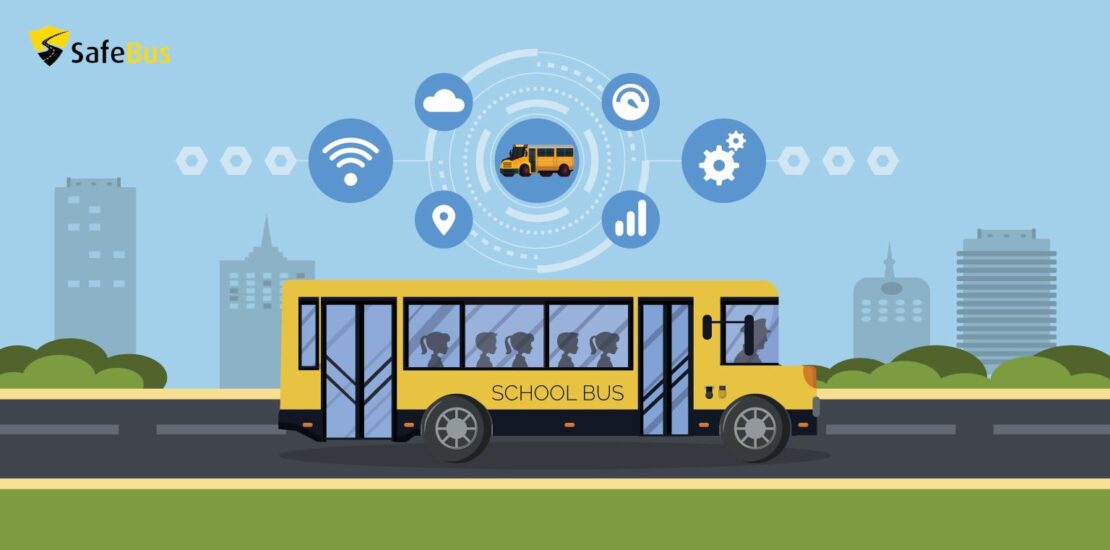- June 15, 2021
- Posted by: Satvir
- Category: Blog

Planning optimal bus routes is more than a matter of timetables and spreadsheets. The post-pandemic landscape is about delivering a safe, secure commute experience to students from home to school and back again. Against this backdrop, fleet managers are adopting AI and IoT-based solutions to achieve optimal efficiency in keeping with strict safety protocols.
Before we proceed to look at how, let us first understand why the combination of AI and IoT is key to unlock advanced routing capabilities.
A look at the benefits offered by AI and IoT-led technologies
Technological assistance is augmenting human efforts to solve modern world problems. Technologies at the forefront of digital innovation are now automating time-consuming and repetitive tasks. They are also simplifying and streamlining workflows for human operators, allowing them to undertake more productive tasks. For these reasons and more, AI and IoT-powered tech frameworks are disrupting innumerable industries.
Click here to know the role of technology in school bus safety
In the design and construction sectors, for instance, AI and IoT are being used to create detailed descriptions and maps of various components and finished products. In the rapid transit sector, they are being used to predict runtimes, manage frequencies based on passenger and travel requirements, etc. Following the viral outbreak, these technologies assisted healthcare professionals in rapid testing, carrying out screening processes, compiling information, and helping to deliver supplies far and wide.
With schools reopening after extended lockdowns, safety and hygiene on the journey to school have emerged as priorities that can no longer be overlooked. Ensuring compliance to all prescribed precautions while enhancing the efficiency of fleet operations has emerged as the next frontier for these technologies to overcome.
The application of AI and IoT-driven systems in the school bus routing segment is the need of the hour. Advanced school bus fleet management software such as SafeBus can help fleet managers build a safer, equitable, and harmonious environment for all stakeholders on the journey to and from school. How? By tapping into the combined power of cloud computing, real-time data analytics, and GPS-linked configurations to streamline on-ground operations like door-to-door routing while eliminating human error.
Driving into a smarter, safer, and healthier future with advanced fleet management solutions
Through SafeBus, fleet managers can automate route planning, roster creation, and fleet scheduling processes, while addressing newer issues that have arisen with the pandemic. Powered by proprietary algorithms, the automated platform can plan and implement optimal routes for each vehicle in the fleet. It achieves this by analyzing historical location-based data and real-time road traffic information. The data-driven insights allow fleet managers to reduce the average trip duration and distance traveled every day.
Such tech interventions can reduce commute durations, affording students more time to relax or pursue their interests. The intelligent system can also reduce stress on bus drivers by ensuring they don’t traverse unpredictable routes or spending more time on the road. It achieves this by adjusting the predetermined route after taking into account unforeseen contingencies such as traffic, construction, or a VIP pass-by. Bus route optimization also helps save fuel costs. Combined with scheduled maintenance reminders, AI and IoT-driven solutions can help school admins bring down the costs of their fleet management and transport operations by up to 30%.
Click here to know, how can school districts reduce operational costs?
The geofencing feature also lends the automated system the agility to account for and eliminate the possibility of the bus passing through COVID-contaminated zones either in transit or during pick-ups and drop-offs. The software can alter the route on the move while still catering to the requirements of all aboard. The provision of automated checklists further empowers school transport teams to document and manage staff/student health statistics, such as body temperature and vaccination status. In case any individual shows signs of sickness, they can be immediately identified and isolated. The digital roster allows transport officials to trace everybody the infected person may have come in contact with, thereby bolstering the efforts to curb accidental transmission and spread of the virus.
These checklists also enable transport officials to efficiently manage vehicle sanitization schedules and inventory management of essential supplies in each vehicle. Relevant stakeholders can access all of this information on their app or centralized dashboard to optimize decision-making by minimizing the scope of human errors.
Taking a holistic approach to school transportation
Preventing onboard misbehavior and violation of safety protocols will be a priority for school administrations for the foreseeable future. Automated fleet management systems can help them take the burden off the bus drivers who are conventionally responsible for ensuring in-vehicle decorum. With a live tracking feature and CCTV integration, administrators can not only monitor the location of the bus but also make immediate interventions in case they observe cases of misdemeanor taking place. The student app offers the users a soft SOS button that they can use to alert the authorities in case of safety, health, and interpersonal violations.
Click here to know, how to maximize school bus transportation security?
Similarly, the parent application and fleet manager dashboard updates respective stakeholders with the latest information, be it ETAs, boarding/deboarding status, or student attendance. The system also sends out notifications to flag cases of rash driving, traffic snarls, or contingencies such as engine breakdown. Real-time updates about such situations allow parents, school admins, as well as fleet operators, to take corrective actions immediately.
AI and IoT-enabled fleet management systems are thus equipped to ensure student safety, counter operational calamities, and maintain financial efficiency. The AI and IoT boom has finally reached the school bus industry. To ensure a speedy journey into a safer, smarter, and healthier future for all, adopting advanced technologies is no longer an option but a non-negotiable imperative.
